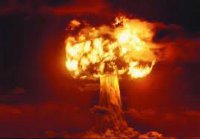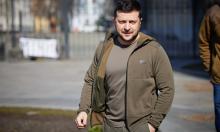First-ever atomic bomb developed by Nazi Germany?
 Recently, rumors started circulating again about the fact that the first nuclear weapons were developed and successfully tested not in the U.S., but in Nazi Germany. Did the Nazis really manage to build an atomic bomb?
Recently, rumors started circulating again about the fact that the first nuclear weapons were developed and successfully tested not in the U.S., but in Nazi Germany. Did the Nazis really manage to build an atomic bomb?
The theory about the development of nuclear weapons by the Nazi is among those hypotheses that can neither be confirmed nor denied (and according to the rules adopted by the contemporary science, including history, they are automatically considered to be unreliable). Most often, the authors mention some secret documents allegedly kept in the archives of the secret services of the former enemies of Germany. Of course, it is difficult to say whether this is true or not, since no one saw these documents other than their authors.
There is a standalone theory that was suggested in 2005 by a German historian Rainer Karlsch in his book "Hitler's Bomb. In this monograph, the author, citing eyewitness accounts, shows that in 1944 on the Baltic island of Rügen and in the spring of 1945 in Thuringia atomic bombs were tested. All these data are based on the testimony of local residents and journalists from the countries of Germany's allies who spoke about the blasts accompanied by intense light flashes.
The testimony of a certain Claire Werner recorded and documented in the 1960s by the city authorities of Arnstadt, where, according to historians, they are still stored in local archives. A Wehrmacht officer Frau Werner knew said to her in an outburst of frankness in the spring of 1945 that "tonight something will happen that can shake the world." The intrigued lady perched herself by the window where she could observe what was happening at the military training ground near the Thuringian town of Ohrdruf. Then the night turned to day: "I saw a huge pillar rising into the sky, and suddenly it was so light that you could read a newspaper. The pillar rushed into the sky, turning into a huge tree with a wide crown".
Other testimony about the testing in Thuringia said that the explosion caused damage in a radius of 500 meters. In particular, several hundred prisoners of war who were used as testing material have been killed. Some of them burned without a trace. One of the participants in these tests said that many nearby residents have complained of nausea and nose bleeding over the next few days after the tests. One witness testified that he helped to burn a great number of dead bodies the next day: they were all bald, and some had blisters on their body and naked raw red flesh.
In addition, Karlsch refers to the results of the measurements carried out later by the U.S. military on the ground test site in Thuringia where traces of radioactive isotopes were found. In particular, soil samples showed the presence of radioactive elements, namely uranium, plutonium, cesium 137 and cobalt 60. Summing up all these and other facts, Mr. Karlsch concludes that by the end of the war the Germany already had a completely ready atomic bomb. Had the country managed to establish its serial production, the results of the World War II could have beeen somewhat different.
However, Rainer Karlsch in his book says that all these facts are not indisputable evidence of his hypothesis. In fact, a bright flash and a cloud that resembles a mushroom can sometimes occur as a result of the explosions of conventional, though quite powerful bombs (and not just bombs - many witnesses of the tragedy of September 11, 2001 in the United States said that a cloud of smoke and dust rising from the collapsing Twin Towers looked like a "mushroom cloud"). The isotope of uranium found in soil was not the one used in an atomic bomb. Hair loss and sores on the bodies of the dead may appear not only due to ionizing radiation, but also because of the use of shells with chemical weapons.
However, the main thing is that in March of 1945, when the tests in Thuringia were allegedly conducted, allied troops were already very close. Why did their seismographic tools (available in each army) not detect any strong shaking? They should have taken place because, judging by the witnesses' testimony, the blast was of "land" type. They are detected by seismographs fast enough. This information is unlikely to have been ignored by the command of the allies' troops.
However, in this article, I am not going to engage in denial or confirmation of Karlsh's hypothesis because, unlike him, I do not have access to secret archives of the intelligence. I would like to simply analyze the purely theoretical possibility of nuclear weapons being created by the Germans at the end of the war. As we know, for such a weapon to appear, two things are required: scientific developments and related industrial technologies. Did the Nazi Germany have these two components?
In terms of the first component, the Germans obviously had an absolute priority. Back in 1938 the global scientific community was shaken by the news of the discovery of the German physicists Otto Hahn and Fritz Strassmann who found that the core of uranium isotope 235U is in an unstable condition and under certain environmental conditions can be divided into two parts, which release massive amounts of energy. This means that the Germans were the pioneers in the field of nuclear energy.
A little later, on Sept. 26, 1939, in Berlin, the department of military weapons held a meeting of the leading German physicists. Among others, the meeting was attended by such famous scientists as the founder of modern quantum mechanics Werner Heisenberg and Carl von Weizsacker, who described the fusion occurring in the interiors of stars. As a result, Germany has commenced the so-called "Uranium Project", whose goal was to create the first nuclear reactor. That is, the theoretical basis for research was very strong. However, the practical implementation has apparently never happened.
Why not? First, because construction of a reactor requires uranium in pure form and large quantities. Germany barely has any deposits. At Czechoslovakia's Jáchymov field controlled by the Nazis since 1938, the uranium compounds are quite difficult to separate from other metals contained in the ore (according to Soviet experts who studied Jáchymov ore after the war, from 16 tons of rock one could get no more than four to six tons of uranium). This uranium was sufficient for laboratory tests, but not enough to create a reactor.
It was also said that after the seizure of 1,200 Belgium tons of finished ore concentrate of uranium oxide produced in the country were at the disposal of the Germans. However, it seems that the Nazis never used it. According to the reports from the U.S. and Soviet military, nearly the same amount of material was diverted to the U.S. and the USSR after the defeat of Germany, and it was the same Belgian uranium.
But there is more to it. To make nuclear fuel it is not enough to clear uranium from impurities. Studies show that for experiments with nuclear reactors, uranium metal was required that in turn necessitated the development of a technology for its casting. The engineering firm Degussa was tasked with it, but they were able to produce uranium metal only by December of 1944. That is, the trials on the island of Rügen that took place according to Karlsh in the late summer of that year could not involve an atomic bomb because there were simply no required raw materials.
However, the introduction of the technology and casting of uranium does not lead to the creation of an atomic bomb. Natural uranium at 99.3 percent consists of the isotope 238U, which is quite stable, and for the nuclear fuel its unstable "brother" 235U is used. To obtain it, uranium is enriched by special devices. These experimental devices have been found in German laboratories by the Soviet and American specialists, but those that could carry out enrichment on an industrial scale have not been found (no technical documentation to support their presence was found either).
Apparently, despite the existence of the scientific equipment, the German Nazis did not succeed in the implementation of the idea of the atomic bomb. Interestingly enough, a Soviet specialist Kikoin working on the domestic "uranium project," who in 1945 acted as an expert on German nuclear research, said: "... Among the secret documents we found the uranium project. We were not mistaken, and Kaiser-Institute was fundamental in this issue. According to the reviewed documents, it became clear that the Germans did not outrun us, on the contrary, they had a very low scientific and technological level in terms of questions presenting interest for us.
However, they have experimentally observed the beginning of a chain reaction (neutron multiplication). As a moderator they used heavy water obtained from Norway. We found two five-liter cans of heavy water labeled Norsk Hydro. We also found some metallic uranium and several kilograms of uranium oxide.
We dismantled and sent to Moscow some of the remaining in the Kaiser-Institute equipment (electrical, instrumentation). Some very simple isotope separators we also sent to Moscow ..."
The German scientists who worked on the "uranium project" repeatedly said that creation of a nuclear bomb would require a great deal of time which Germany did not have. Werner Heisenberg in a conversation with Niels Bohr in 1941 said that the creation of nuclear weapons in Germany was possible in principle, but it would require such extraordinary technical efforts, that hopefully it would not be able to implement during that war. It seems that this prediction of the great physicist brilliantly confirmed. The atomic bomb had not been created by the Nazis.
- However, later created myth that Germany still has nuclear weapons turned out to be extremely tenacious, like many other myths about the extraordinary achievements of the scientists of the Third Reich.
Anton Evseev- Pravda.Ru
Subscribe to Pravda.Ru Telegram channel, Facebook, RSS!





